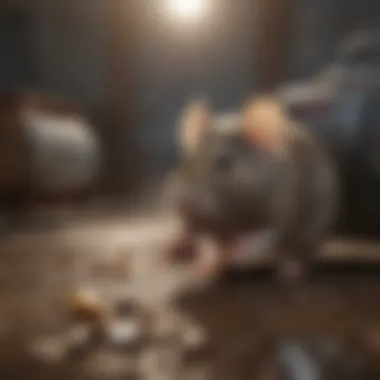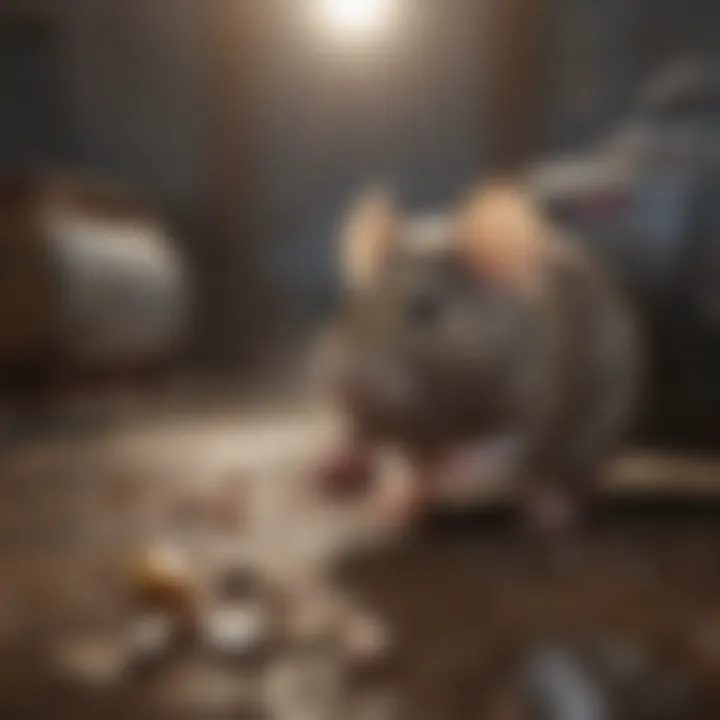Understanding Mouse Bait Stations: Mechanisms & Effectiveness


Intro
Mouse infestations can be a daunting issue for homeowners. The presence of these pests can create discomfort and various health concerns. Understanding mouse bait stations is vital for those looking to combat rodent problems effectively. This section aims to lay the groundwork for comprehending the nuances of these devices and their role in pest management.
Understanding Pests
Definition of Pests
Pests are organisms that can cause harm to crops, livestock, or human health. In the context of homes, pests often refer to rodents like mice, which can damage property and spread diseases.
Importance of Pest Identification
Identifying the specific type of pest is critical in strategizing effective control measures. Different pests require varying approaches. Mice, for instance, are often associated with food contamination and structural damage. Recognizing their signs, such as droppings or gnaw marks, can help in determining the appropriate methods of management.
Mice are attracted to places where food is accessible. They are more likely to invade homes during colder months when they seek warmth and shelter. Hence, recognizing the problem early can prevent larger infestations.
Prevention Techniques
Home and Garden Preventative Measures
Preventative measures are essential in keeping your home free from mouse infestations. Here are some useful strategies:
- Seal Entry Points: Mice can enter through small openings. Check baseboards, windows, and doors for gaps and seal them using caulk or steel wool.
- Maintain Cleanliness: Proper sanitation can deter mice. Keep food stored in airtight containers and dispose of garbage regularly.
- Manage Outdoor Areas: Keep gardens tidy and restrict access to areas that can provide shelter. Storing firewood away from the home can also help.
Seasonal Prevention Tips
With changing seasons, prevention strategies may need adjustments.
During the fall, inspect your home thoroughly for potential entry points. In spring and summer, maintain your yard to minimize hiding spots for mice.
Eco-Friendly Pest Control Solutions
Overview of Sustainable Practices
Homeowners may consider eco-friendly approaches to pest control. These methods focus on reducing harm to the environment while managing pest populations. Please consider these options:
- Using Mouse Bait Stations: Opt for bait stations designed to attract and eliminate rodents efficiently while minimizing risks to non-target species.
- Employing Traps: Traditional traps can be effective and avoid the use of poisons that may pose risks to children or pets.
Natural Remedies and Their Effectiveness
Natural remedies can also offer solutions, though their effectiveness varies. Common natural deterrents include:
- Peppermint Oil: Its strong scent is said to deter mice. Consider placing cotton balls soaked in peppermint oil near entry points.
- Ultrasonic Devices: These devices emit high-frequency sounds to dissuade rodents without chemicals.
Prelude to Mouse Bait Stations
Understanding mouse bait stations is crucial for effective pest management in households and businesses. These devices play a pivotal role in controlling rodent populations, which can harbor diseases and cause structural damage. By learning about bait stations, homeowners can implement a more strategic approach to pest control, ensuring their living spaces are safe and healthy.
Defining Mouse Bait Stations
Mouse bait stations are enclosed devices designed specifically to hold rodent bait securely. The main idea is to attract rodents while restricting access to other animals and children. They usually consist of a durable material that withstands outdoor elements. The design allows for easy monitoring and replenishment of bait, making them practical for homeowners.
Bait stations can vary in size and functionality. Some are designed for indoor usage, while others are meant for outdoor settings. Their purpose is clear: to trap or poison rodents effectively while minimizing risks to non-target animals and people. Knowing how these stations function is the first step in utilizing them efficiently for pest control.
Integration in Pest Management Strategies
Incorporating mouse bait stations into an overall pest management strategy can enhance the effectiveness of rodent control measures. They work best when used alongside other methods like sealing entry points, maintaining cleanliness, and utilizing traps. When you integrate bait stations, you create a multi-faceted approach, addressing the problem from different angles.
It is important to consider the environment when placing bait stations. Factors like the layout of a home, the presence of pets, and the frequency of rodent sightings should guide decisions on placement. A strategic integration means assessing the unique needs of the space and modifying the approach accordingly. Therefore, homeowners must stay informed about their use to protect their living environments effectively.
"Proper understanding and strategic implementation of mouse bait stations can drastically reduce rodent infestations in homes."
In summary, mouse bait stations are not just simple containers. They are a fundamental component of an effective pest management strategy. By defining their purpose and integrating them thoughtfully, homeowners can significantly improve their ability to control rodent populations.


How Mouse Bait Stations Work
Understanding how mouse bait stations work is essential for effective pest management. These devices are designed to maximize the targeting of rodents while minimizing risks to humans and pets. The better one understands the underlying mechanisms and different bait types, the more efficient the pest control efforts can be.
Principles of Operation
Mouse bait stations function through specific principles aimed at attracting rodents. The primary mechanism is based on the concept of attraction. Rodents have certain instincts and behaviors that lead them to food sources. Bait stations leverage these instincts by using scented baits that appeal to the rodent's feeding preferences. This makes bait stations pivotal tools in controlling mouse populations.
Typically, a bait station is a secure box containing poison or other rodenticides. The design of the station ensures that only rodents can enter, safeguarding children and pets. Once the rodent consumes the bait inside, it quickly becomes the target of the management strategy. These stations should be regularly checked to ensure they remain accessible and effective.
"A bait station's effectiveness is closely linked to its proper placement and maintenance."
The operation of a bait station relies heavily on its mechanical design. Effective bait stations must have several features: they must be weatherproof, prevent non-target species from accessing the bait, and provide a stable environment for the bait itself. This enables the bait to remain effective for a more extended period. Overall, principles of operation are not just about placing bait, but creating a secure, appealing environment for rodents to feed.
Types of Baits Used
Baits play a crucial role in the success of bait stations. There are multiple types of baits that can be used, which cater to the varied preferences of rodent species. The two primary categories of bait are commercial baits and homemade baits. Each has its advantages and drawbacks.
- Commercial Baits: These baits are formulated for maximum effectiveness and typically contain various rodenticides. Some common types are:These baits often come in blocks or pellets, making them easy to place in bait stations while ensuring that they are appealing to rodents.
- Homemade Baits: These are generally prepared from common household items. Examples include mixtures of peanut butter with certain aversive agents. However, using homemade options can sometimes lead to lower efficiency and inconsistent results. Illicit or less effective ingredients can pose risks to pets and children.
- Bromadiolone
- Brodifacoum
- Difenacoum
Choosing the right bait often requires understanding the habits and preferences of the local rodent population. Factors such as food availability in the environment or the specific rodent species can greatly influence bait preference. Therefore, a bait station's success hinges not just on its design and location but also significantly on the choice of bait used.
Design Characteristics of Bait Stations
The design characteristics of mouse bait stations play a vital role in their effectiveness as part of pest control strategies. A well-designed bait station maximizes the chances of attracting and controlling rodent populations while ensuring safety and ease of use for homeowners. Focused attention on materials, construction, size, and shape are essential components that enhance the functionality and accessibility of these devices.
Materials and Construction
Materials used in bait station construction directly impact their durability and attractiveness to rodents. Common materials include heavy-duty plastic, metal, and wood. Heavy-duty plastic is popular due to its resistance to weather elements, such as rain or snow. Metal options may offer higher durability against tampering, particularly in areas with larger wildlife.
The construction quality must also ensure that bait stations are tamper-resistant. This is particularly important when there are children or pets in the vicinity. A station that can not be easily opened helps prevent accidental exposure to bait. Further, it is vital that the design includes some sort of locking mechanism to keep the bait secure.
Size and Shape Considerations
The size and shape of bait stations are determined by several factors, including the type of rodent it aims to attract and the environment where it will be placed. Generally, bait stations should be large enough to hold sufficient bait but compact enough to fit in tight spaces.
When selecting these devices, consider shapes that can accommodate multiple access points. This can be beneficial in crowded environments where rodents may be accustomed to navigating varied pathways. A rectangular design, for instance, can be advantageous in narrow spaces, such as between walls or beneath furniture. Conversely, rounded shapes may blend more subtly into outdoor settings.
A practical dimension for bait stations are those that are approximately 10 x 5 x 5 inches. This size is usually sufficient to attract both mice and rats without taking too much space. The shape should allow both easy access for rodents and protection from the elements.
In summary, design characteristics such as material choice, construction quality, dimensions, and shape significantly influence the effectiveness of bait stations. By understanding these elements, homeowners can make informed choices to enhance their pest management strategies.
Optimal Bait Selection
Bait selection is a crucial component when it comes to the effectiveness of mouse bait stations. Using the right bait increases the likelihood of attracting rodents, thereby enhancing pest control efforts. Selecting the optimal bait requires understanding the dietary preferences of the target rodent species, the environmental conditions in which the bait is placed, and how to best utilize both commercial and homemade options.
Assessing Rodent Preferences
When choosing bait, it is important to consider what different rodents typically seek. House mice, for instance, are omnivorous and have varied dietary inclinations. They are often drawn to foods that are high in fats and sugars. Common preferences include peanut butter, sunflower seeds, or even dried fruits. By assessing these preferences, homeowners can effectively tailor their baiting strategies.
Bait needs to be appealing enough to encourage rodents to enter the station.
Furthermore, the nutritional value of the bait can determine how frequently rodents may return. It's also necessary to monitor activity levels around the station; if there isn’t much interaction with the bait, it might be time to reassess what’s being used. Observing what's available in the environment can also guide these decisions, as rats and mice can be selective based on food hierarchy.
Commercial vs. Homemade Bait Options
There are advantages to being informed about both commercial and homemade bait options. Commercial baits are formulated to be highly attractive, but might come with safety concerns, especially in households with children or pets. Products such as d-CON or Tomcat, which contain anticoagulants, can effectively eliminate rodents but should be handled with caution.
On the other hand, homemade bait provides customization benefits. Options like a mix of oats and peanut butter, or chunks of cheese, tend to be effective and safer alternatives. Additionally, homemade baits can be more cost-effective, appealing to budget-conscious homeowners.
To decide between the two, consider the following:


- Safety: Assess if commercial bait is suitable for your environment.
- Effectiveness: Evaluate your specific rodent problem and adapt bait accordingly.
- Cost: Calculate if DIY bait meets your needs without overspending.
In summary, successful pest control through bait stations hinges significantly on optimal bait selection. Balancing rodent preferences with safety and effectiveness will lead to better results.
Strategic Placement of Bait Stations
Strategic placement of bait stations plays a crucial role in the effectiveness of rodent control strategies. The goal is to ensure the bait stations are positioned in ways that maximize their potential to attract and eliminate rodents. When these stations are set up thoughtfully, the likelihood of successful pest management increases, thereby reducing the risks posed by rodent infestations.
Identifying High Traffic Areas
Identifying areas with high rodent activity is essential. Rodents tend to follow the same paths. This behavior is due to their instincts and an innate fear of open spaces. Installation in these traffic routes enhances the chance of rodents encountering the bait. Key locations include:
- Near food sources: Bait stations should be placed in proximity to areas where food is stored or consumed. Rodents are opportunistic feeders and are likely to search for food.
- Along walls and corners: Rodents often travel close to walls to feel secure. Therefore, placing bait stations within a foot of walls is likely more effective than placing them in open spaces.
- Near nesting sites: If there are signs of rodent activity, such as droppings or gnaw marks, these areas should be prioritized for bait station placement.
By focusing on these high traffic areas, the effectiveness of bait stations can be significantly improved, ultimately increasing rodent capture rates.
Environmental Factors to Consider
Several environmental conditions can influence the placement and effectiveness of bait stations. It is vital to assess these factors thoroughly:
- Moisture levels: Rodents are often attracted to damp environments. Placing bait stations in areas with excessive moisture might prevent rodents from entering, as they favor drier locations.
- Temperature fluctuations: Extreme temperatures may deter rodents. Bait stations should be placed in sheltered locations to protect them from harsh environmental conditions.
- Presence of competing food sources: If there are abundant food options in the vicinity, such as pet food or compost, the bait station may be overlooked. It's crucial to remove or minimize these competing sources.
Safety and Precautions with Bait Stations
Ensuring safety when using mouse bait stations is paramount. These devices, while effective in controlling rodent populations, can pose risks, particularly to children and pets. Understanding safety measures is crucial for homeowners who wish to manage pests without compromising the well-being of their family members.
The primary focus here lies on creating a secure environment where bait stations are used. Homeowners should recognize the potential dangers associated with rodent baits, which may contain toxic substances. This highlights the need for a strategic approach when employing such solutions.
Child and Pet Safety Measures
When integrating bait stations within a home, special attention must be given to child and pet safety. The most effective way to achieve this is to place bait stations in inaccessible locations. Here are some key measures:
- Placement Location: Install stations in areas that are out of reach for children or pets. This often includes behind appliances or in enclosed spaces such as basements and attics.
- Use of Locked Stations: Some bait stations come with locks, ensuring that only intended targets can access the toxins inside. Consider using these types for enhanced safety.
- Education: Teach children about the dangers of tampering with pest control products. Awareness can significantly reduce the risk of accidental exposure.
Additionally, routinely check the conditions surrounding bait stations. If you notice any expired or uncovered bait, dispose of it immediately to prevent unintended contact with children or pets.
Handling Bait Safely
It is equally essential to handle bait product accurately when setting up bait stations. Proper handling helps minimize risk and ensures that the application is effective. Here are guidelines for safe handling:
- Personal Protective Equipment (PPE): Always wear gloves when handling bait. This reduces the risk of ingestion or contamination during setup.
- Follow Manufacturer Instructions: Each bait product typically comes with specific guidelines. Adhering to these can help avoid dangerous situations. The instructions often include essential information on dosage and placement.
- Secure Storage: Store all bait materials in a secure location. This may mean using childproof containers and keeping them high up on shelves, away from reach.
Homeowners must also dispose of any unused bait following local regulations. Never throw bait into regular trash without protection, as it may pose a hazard to other animals.
"Safety first: it is crucial to ensure that both children and pets are shielded from exposure to toxic baits."
In summary, understanding the safety aspects surrounding bait stations is not just an option; it’s a necessity for responsible pest management. With appropriate measures, the risks can be significantly minimized, allowing for a balance between effective rodent control and the safety of loved ones.
Monitoring and Maintenance
Monitoring and maintenance are essential factors in the effectiveness of mouse bait stations. Proper attention to these elements ensures that bait stations operate at peak performance and contribute to successful rodent control. When mice invade a space, the situation can escalate rapidly. Therefore, homeowners must adopt an active approach in monitoring their bait stations.
Regular checks help identify if the bait is being consumed and if the stations are still secure and effective. It is important to replenish bait regularly to maintain its attractiveness. By doing so, homeowners can minimize the rodent population and prevent potential infestations. This vigilance ensures that any changes in rodent activity are quickly addressed. Furthermore, ongoing maintenance can prevent spills, contamination, and other hazards associated with bait usage.
Regular Checks and Replenishment
Conducting regular inspections of bait stations is crucial. Homeowners should check them at least once a week, or more frequently if infestations are severe. During these checks, look for signs of bait consumption or any presence of rodents. If bait is completely or mostly eaten, this indicates active rodent activity and signals a need for more bait.
Replenishment of bait should be timely, ensuring that stations are always stocked. This proactive approach prevents bait from becoming stale or less appealing. Consider using protein-based or grain-based baits, as these tend to attract various rodent species effectively. Keep in mind that the environment can influence how quickly bait is consumed, especially in areas with higher moisture or other competing food sources. Monitor these factors closely.
Signs of Effectiveness
Determining the effectiveness of bait stations primarily involves observing rodent population changes. Success may be indicated by a noticeable decrease in rodent activity within a specified area. Homeowners should be aware of several signs that demonstrate effectiveness:


- Decreased sightings of live rodents: A reduction in the number of rodents observed is a positive indicator.
- Less evidence of droppings or gnaw marks: When areas around the bait stations show fewer signs of rodent activity, it signals that bait is working.
- Stability in bait consumption rate: If monitoring reveals a consistent pattern of bait being consumed, this suggests effectiveness.
"Consistent monitoring and timely maintenance of bait stations are key to successful pest control strategies."
Even though signs of effectiveness can be a good indicator, regular evaluations should be complemented with adjustments in bait type or placement to further refine the strategy. By remaining vigilant, homeowners can effectively address rodent issues and ensure the long-term effectiveness of mouse bait stations.
Evaluating Effectiveness of Bait Stations
Evaluating the effectiveness of bait stations is crucial in pest management. It provides insights into how well these devices are achieving their intended purpose: controlling rodent populations. By measuring the success rate, homeowners and pest control professionals can optimize their strategies and reduce the potential risks associated with rodent infestations. This section discusses essential elements related to assessing and adjusting bait station strategies.
Assessing Rodent Population Changes
Assessing changes in rodent populations is a direct method to evaluate the performance of bait stations. Observing the number of rodent sightings or traps over time can indicate whether populations are decreasing or remaining stable. Effective monitoring includes:
- Tracking Sightings: Keep a log of sightings before and after introducing bait stations. This can reveal shifts in rodent activity.
- Inspecting Bait Consumption: If the bait is regularly consumed, it suggests that the stations are drawing rodents effectively. Conversely, a lack of bait consumption may indicate poor placement or unattractive bait choice.
- Using Traps: Employ traps in conjunction with bait stations. Regular trap checks will provide more detailed insight regarding population trends.
It is important to perform these assessments regularly to ensure timely responses to changes in rodent behavior. By understanding these patterns, adjustments can be more effectively implemented.
Adjusting Strategies Based on Results
After evaluating the effectiveness of bait stations through observation and data collection, it is essential to adjust strategies based on the results found. Some considerations include:
- Modifying Bait Types: If certain baits are not appealing to the target rodent species, experimenting with different bait formulations may yield better results.
- Repositioning Stations: If particular bait stations are not attracting rodents, reevaluating their placement could be necessary. Consider areas that might have better visibility for rodents.
- Enhancing Bait Protection: In instances where non-target animals are getting to the bait, ensuring that bait stations are secure may protect the bait and also enhance effectiveness.
Adjustments should be made based on clear evidence, rather than assumptions.
Ultimately, the goal is to refine pest control strategies continuously. Therefore, keeping an eye on rodent population dynamics and being willing to pivot is vital for successful bait station use.
Common Misconceptions About Bait Stations
Understanding mouse bait stations involves clearing the air around the common misconceptions that often surround them. These misconceptions can affect how homeowners approach rodent control, impacting their choices in pest management strategies. By addressing these myths, we can help readers make informed decisions that enhance their efforts in dealing with mouse infestations.
Effectiveness Myths
One prevalent myth is that bait stations are ineffective if they do not lead to immediate results. People often expect rapid eradication, failing to realize that rodent baiting is a process requiring time and patience. The effectiveness of bait stations can be influenced by several factors, including bait type, placement, and the size of the rodent population. A good bait station does not guarantee instant death but works gradually to eliminate rodents seeking a food source.
Bait stations are also sometimes viewed as a one-size-fits-all solution. It's crucial to understand that different rodent species may have distinct preferences and behaviors. Using the right bait, strategically placed in areas where activity is high, increases the likelihood of catching the target species.
"Bait stations need time and strategic approach to effectively manage rodent problems."
Some people unjustly believe that using multiple bait stations will always yield better results. Over-saturating an area can actually hinder effectiveness. Rodents may become wary of the numerous bait stations, potentially leading them to avoid them altogether. Thus, quality in placement and bait selection is often more effective than sheer quantity.
Safety Concerns Clarified
Another significant area of misconception centers around safety concerns. Many people fear that bait stations pose a risk to children and pets. However, modern bait stations are designed with safety in mind. They are equipped with features that limit access to the bait, minimizing the risk of accidental ingestion. Most bait stations will have secure entry points that deter unintended access while allowing rodents easy entry.
It is important that individuals using bait stations familiarize themselves with the specific product's safety instructions. Correct placement away from curious hands and paws is a fundamental precaution.
Some may also believe that all rodenticides are equally harmful. However, this is not true. There are many types of baits available, many of which are designed with lower toxicity levels for non-target animals. Understanding the options available, as well as their respective safety profiles, is vital for anyone considering bait stations.
Closure
Understanding the role of mouse bait stations is crucial in establishing effective pest control strategies. These devices provide a systematic approach to manage rodent populations, which can cause significant damage to properties and pose health risks. Recognizing their importance in integrated pest management ensures that homeowners and pest control professionals can deploy them strategically to achieve better results.
Importance in Integrated Pest Control
Mouse bait stations serve as a vital component within broader pest control frameworks. Their design promotes efficient bait delivery while reducing risks to non-target species. By minimizing accidental poisoning of pets and children, these devices introduce a level of safety in pest management that is often overlooked.
Furthermore, bait stations enable sustained monitoring of rodent activity and population dynamics. Homeowners can assess bait consumption and frequency of visits, informing when additional measures might be needed. This data-driven approach increases the overall effectiveness of pest control efforts.
Future Innovations in Bait Technology
The realm of bait technology is evolving rapidly. Future innovations may focus on bait formulations that not only attract rodents but also address specific species behaviors. For instance, using multi-modal attractants that engage their senses more effectively could significantly enhance efficiency.
Moreover, the integration of smart technology into bait stations might soon allow for real-time monitoring. Devices that can notify homeowners via smartphone apps about bait consumption and rodent activity could redefine how pest control is approached. These advancements promise to make mouse bait stations even more effective and user-friendly, allowing for proactive measures against infestations before they escalate.
By embracing innovation, homeowners can adopt safer, more effective methods for managing rodent populations, ultimately leading to enhanced integrity of their living spaces.
In summary, the significance of mouse bait stations in pest management cannot be understated. As technology continues to advance, the effectiveness and safety of these devices will likely improve, aligning with the needs of conscientious homeowners.



